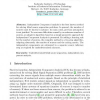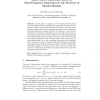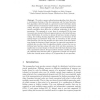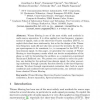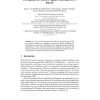115
Voted
ICA
2010
Springer
15 years 1 months ago
2010
Springer
Independent Component Analysis is the best known method for solving blind source separation problems. In general, the number of sources must be known in advance. In many cases, pre...
114
click to vote
ICA
2010
Springer
15 years 1 months ago
2010
Springer
Abstract. A new dictionary learning method for exact sparse representation is presented in this paper. As the dictionary learning methods often iteratively update the sparse coeffi...
ICA
2010
Springer
15 years 1 months ago
2010
Springer
In this paper, we propose a novel method for blind source separation (BSS) based on time-frequency sparseness (TF) that can estimate the number of sources and time-frequency masks,...
98
Voted
ICA
2010
Springer
15 years 1 months ago
2010
Springer
Abstract. We discuss causal structure learning based on linear structural equation models. Conventional learning methods most often assume Gaussianity and create many indistinguish...
119
click to vote
ICA
2010
Springer
15 years 1 months ago
2010
Springer
We study a sparse coding learning algorithm that allows for a simultaneous learning of the data sparseness and the basis functions. The algorithm is derived based on a generative m...
124
click to vote
ICA
2010
Springer
15 years 1 months ago
2010
Springer
Abstract. In this work, we present a direction-of-arrival (DOA) estimation method for narrowband sources impinging from the far-field on a uniform linear array (ULA) of sensors, ba...
113
click to vote
ICA
2010
Springer
15 years 1 months ago
2010
Springer
Wiener filtering is one of the most widely used methods in audio source separation. It is often applied on time-frequency representations of signals, such as the short-time Fourier...
68
Voted
BIOSTEC
2009
15 years 1 months ago
2009
In [1
148
Voted
AVSS
2009
IEEE
15 years 1 months ago
2009
IEEE
Visual tracking with moving cameras is a challenging task. The global motion induced by the moving camera moves the target object outside the expected search area, according to th...
126
click to vote
AVSS
2009
IEEE
15 years 1 months ago
2009
IEEE
This paper presents a novel approach to vehicle detection in highway surveillance videos. This method incorporates well-studied computer vision and machine learning techniques to ...
